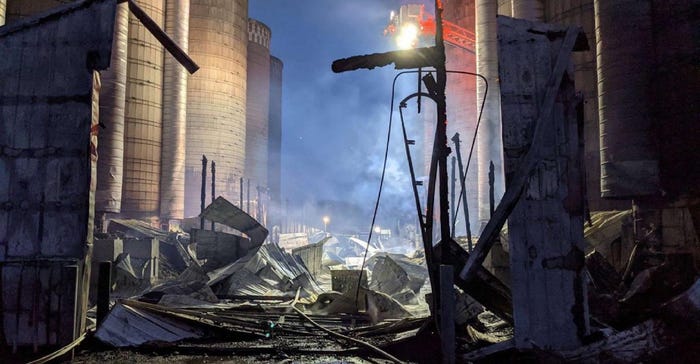
A May 15 fire that consumed and destroyed a feed barn on Michigan State University’s Dairy Cattle Teaching and Research Farm in East Lansing also ignited feed inside of two of the 12 nearby silos and was still burning several days later. No animals or humans were harmed.
Animal science student Anne Tunison, whose father just happens to be a volunteer firefighter, was feeding calves in a nearby pen about 7:45 p.m. May 15 when she smelled smoke.
“I was driving in a gator to see where it was coming from and saw orange flames coming out of the barn door,” she says. “I immediately stopped and called 911. While I was on the phone with the operator, I ran to my co-workers in the milking parlor to tell them what was going on.”
No animals were in immediate danger, but some were moved as a precaution, Tunison says, while she drove down the driveway to meet the police and fire departments to direct them where to go.
The East Lansing Fire Department initially responded, but it was quickly joined by nine other fire departments to extinguish the blaze in about an hour, says Faith Cullens, director of MSU’s South Campus Animal Farm. The cause of the fire is believed to be electrical.
After a windy day May 14, the wind had calmed by May 15. “That was lucky because right next to that feed center is a huge barn of straw,” Cullens says. “And, on the other side of that are all the cow barns.”
The cows didn’t miss a beat. “The cows were milked on time, were fed on time and the research projects are continuing with the exact same diets,” Cullens says. “All the support, with so many people reaching out to help with supplies, has been phenomenal — really heartwarming. We had a skid loader burn up, and Bobcat had a new one there early the next morning.”
A structural specialist was called in to review options for the burning silos. “The fire department said we could just let it burn, but that could take weeks,” Cullens says. “So we have decided that we will have them removed from the top down.”
Early warning
A burning smell was detected on the farm as early as the afternoon of May 14. “The wind was picking up, and we could not figure out where it was coming from,” Cullens says. “We called the East Lansing Fire Department to let them know. They came and did a walkthrough with heat sensor guns looking everywhere, but they couldn’t find anything and cleared it.”
Thankfully, Cullens notes, when the fire department was out that Friday, it was noted how far it was to a hydrant. “So, right away when we called in the fire on Saturday, they knew they needed to bring in the brigade of water trucks, because it was a far distance to try to reach a hydrant.”
Lost were 300 tons of forages and 250 tons of corn. “This will leave us short on feed, and we’re going to be buying feed this year, but for right now we're OK,” Cullens says. “And with the beef farm right down the road, we're getting corn from there.”
The current dilemma is trying to figure out where to store feed. Cullens says they’d like to put in a flat pad to put bunkers in or feed bags on, and construct an inexpensive structure with a roof where small batches of each of the farm’s 18 different research diets for 280 cows could be stored before feeding.
“We don’t want to invest a ton of money into this old facility because we’re hoping to build a new farm in the near future,” says Cullens, who noted organizers are six months into a five-year plan for that project.
“We’re working on something to get us through until we can move to the new farm.”
About the Author(s)
You May Also Like






